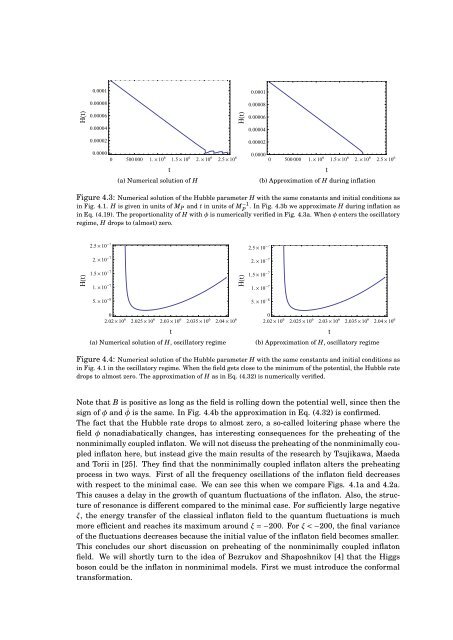Master's Thesis in Theoretical Physics - Universiteit Utrecht
Master's Thesis in Theoretical Physics - Universiteit Utrecht
Master's Thesis in Theoretical Physics - Universiteit Utrecht
Create successful ePaper yourself
Turn your PDF publications into a flip-book with our unique Google optimized e-Paper software.
0.00010.00010.000080.00008Ht0.00006Ht0.000060.000040.000040.000020.000020.00000 500 000 1. 10 6 1.5 10 6 2. 10 6 2.5 10 6(a) Numerical solution of Ht0.00000 500 000 1. 10 6 1.5 10 6 2. 10 6 2.5 10 6t(b) Approximation of H dur<strong>in</strong>g <strong>in</strong>flationFigure 4.3: Numerical solution of the Hubble parameter H with the same constants and <strong>in</strong>itial conditions as<strong>in</strong> Fig. 4.1. H is given <strong>in</strong> units of M P and t <strong>in</strong> units of M −1 . In Fig. 4.3b we approximate H dur<strong>in</strong>g <strong>in</strong>flation asP<strong>in</strong> Eq. (4.19). The proportionality of H with φ is numerically verified <strong>in</strong> Fig. 4.3a. When φ enters the oscillatoryregime, H drops to (almost) zero.2.5 10 7 t2.5 10 7 tHt2. 10 71.5 10 71. 10 75. 10 8Ht2. 10 71.5 10 71. 10 75. 10 802.02 10 6 2.025 10 6 2.03 10 6 2.035 10 6 2.04 10 602.02 10 6 2.025 10 6 2.03 10 6 2.035 10 6 2.04 10 6(a) Numerical solution of H, oscillatory regime(b) Approximation of H, oscillatory regimeFigure 4.4: Numerical solution of the Hubble parameter H with the same constants and <strong>in</strong>itial conditions as<strong>in</strong> Fig. 4.1 <strong>in</strong> the oscillatory regime. When the field gets close to the m<strong>in</strong>imum of the potential, the Hubble ratedrops to almost zero. The approximation of H as <strong>in</strong> Eq. (4.32) is numerically verified.Note that B is positive as long as the field is roll<strong>in</strong>g down the potential well, s<strong>in</strong>ce then thesign of φ and ˙φ is the same. In Fig. 4.4b the approximation <strong>in</strong> Eq. (4.32) is confirmed.The fact that the Hubble rate drops to almost zero, a so-called loiter<strong>in</strong>g phase where thefield φ nonadiabatically changes, has <strong>in</strong>terest<strong>in</strong>g consequences for the preheat<strong>in</strong>g of thenonm<strong>in</strong>imally coupled <strong>in</strong>flaton. We will not discuss the preheat<strong>in</strong>g of the nonm<strong>in</strong>imally coupled<strong>in</strong>flaton here, but <strong>in</strong>stead give the ma<strong>in</strong> results of the research by Tsujikawa, Maedaand Torii <strong>in</strong> [25]. They f<strong>in</strong>d that the nonm<strong>in</strong>imally coupled <strong>in</strong>flaton alters the preheat<strong>in</strong>gprocess <strong>in</strong> two ways. First of all the frequency oscillations of the <strong>in</strong>flaton field decreaseswith respect to the m<strong>in</strong>imal case. We can see this when we compare Figs. 4.1a and 4.2a.This causes a delay <strong>in</strong> the growth of quantum fluctuations of the <strong>in</strong>flaton. Also, the structureof resonance is different compared to the m<strong>in</strong>imal case. For sufficiently large negativeξ, the energy transfer of the classical <strong>in</strong>flaton field to the quantum fluctuations is muchmore efficient and reaches its maximum around ξ = −200. For ξ < −200, the f<strong>in</strong>al varianceof the fluctuations decreases because the <strong>in</strong>itial value of the <strong>in</strong>flaton field becomes smaller.This concludes our short discussion on preheat<strong>in</strong>g of the nonm<strong>in</strong>imally coupled <strong>in</strong>flatonfield. We will shortly turn to the idea of Bezrukov and Shaposhnikov [4] that the Higgsboson could be the <strong>in</strong>flaton <strong>in</strong> nonm<strong>in</strong>imal models. First we must <strong>in</strong>troduce the conformaltransformation.
















